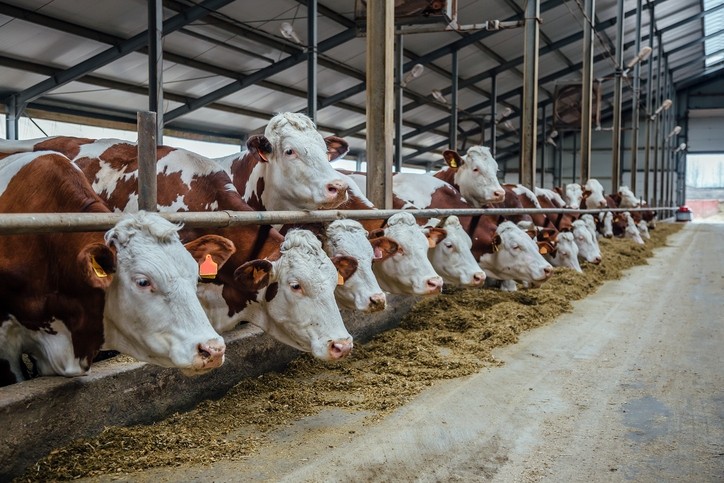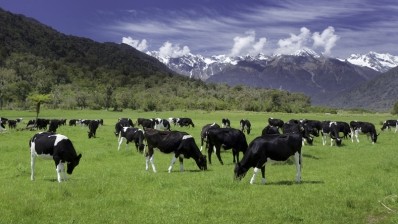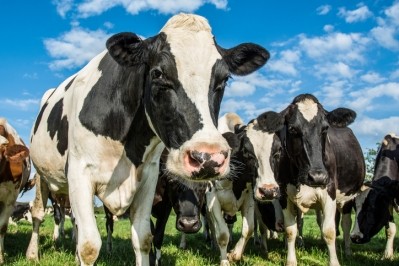Dairy cow efficiency, production sees boost from amylase use with high-starch diet

A team of researchers in Brazil from the University of Lavras, the Better Nature Research Center, Minas Gerais Agricultural Research Enterprise, Federal University of Minas Gerais and with DSM Produtos Nutricionais Brasil examined the use of exogenous amylase in dairy cow diets with high starch levels.
The team published its work in the Journal of Dairy Science.
“The objective of this experiment was to evaluate the 9-wk supplementation of lactating cows fed a 32% starch diet from corn silage, finely ground corn, and rehydrated and ensiled corn grain with exogenous amylase,” the researchers said. “We hypothesized that adding exogenous amylase to the high-starch diet would increase the milk to DMI ratio and the digestibility of starch.”
The research team found that adding the feed supplemented improved milk yield, milk lactose synthesis and plasma glucose concentration while reducing dry matter intake (DMI). Milk fat and protein levels were not altered, but the concentration of urea nitrogen (N) in the blood dropped.
“Amylase improved the feed efficiency of lactating cows fed a high-starch diet; the enzyme increased milk yield and reduced intake,” the researchers said.
Why amylase supplementation for dietary starch?
Dietary starch plays a role in increasing microbial yield in the rumen and contributes to the energy needed for cattle lactation, said the researchers. Supplementing diets of lactating cows with exogenous amylase has been linked to improved ruminal starch digestibility and a boost in ruminal microbial yield and feed efficiency.
However, increasing ruminal starch digestion can also result in ruminal acidosis, which reduces ruminal microbial synthesis and milk solid secretion, they said. The influence nutritional strategies have on ruminal starch digestibility appears to be related to the type of starch found in the diet.
“The increase in ruminal starch digestibility when high-moisture corn replaced finely ground mature corn in high (32%) and low (21%) starch diets was 24.2 and 12.6 percentage units, respectively, suggesting that the ruminal capacity to digest more resistant starch sources is limited,” they said. However, the concentration of volatile fatty acids (VFA) after a period of ruminal fermentation in vitro was increased when amylase was added to flint corn, but not floury corn and the total-tract digestibility of neutral detergent fiber (NDF) may be improved by exogenous amylase supplementation, they added.
The long-term influences of amylase supplementation on dry matter intake, lactation performance and feed efficiency in dairy cows have been inconsistent, they said. In one study adding amylase to a 21% starch diet improved milk yield didn’t alter DMI and tended to improve the milk to DMI ratio, but another reported a drop in DMI, no effect on milk yield and an improvement in feed efficiency.
Additionally, a study that added amylase to a 26% starch diet that included coarsely ground corn for a 14-week period did not produce changes in milk yield, DMI or feed efficiency, the researchers said.
“The long-term effect of amylase supplementation to diets with a high starch concentration has not been evaluated,” they said. “High-starch diets may be an economic alternative when corn prices are low and may be more responsive to amylase supplementation than low-starch diets.”
Methods and materials
In the feeding trial, 28 cows were given one of two diets as a total mixed ration (TMR) for a period of 63 days, the researchers said. Prior to the trial starting all cows were given the same diet for a 14-day acclimation period and samples of dry matter intake (DMI), milk yield, solids levels and milk urea nitrogen (MUN) were taken along with measurements for body weight (BW) and body condition score (BCS).
The diets used in the comparison study were a control, and that diet with 0.5g of enzyme per kg of TMR dry matter of a commercially available exogenous amylase mixed with ground corn, they said. The test diet was designed to contain 300 Kino Novo units of amylase activity/kg of TMR dry matter.
“One Kilo Novo unit is the amount of enzyme that releases in a 2-step α-amylase/α-glucosidase reaction, 6 µmol of p-nitrophenol per min from 1.86 mM ethylidene-G7-p-nitrophenyl-maltoheptaoside at pH 7.0 and 37°C,” they added.
During the feeding comparison, feed intake, body weight, TMR particle size distribution, milk yield and components, urinary output, chewing activity and eating behavior were recorded, they said. Samples of feed, orts, milk, manure, urine, blood and ruminal fluid were collected and analyzed.
Feed efficiency and body weight gain also were calculated, said the researchers. The total-tract apparent digestibility of DM, organic matter (OM), NDF, non-NDF OM and starch were established.
Results
Adding the amylase supplement to the feed boosted yields for milk and milk lactose and reduced dry matter intake, the researchers said. Cows saw improved feed efficiency and tended to see an increase in milk solids yield.
“Amylase increased milk yield and reduced DMI, improving feed efficiency of dairy cows, associated with an increase in plasma glucose concentration and milk lactose synthesis,” they said. “The total-tract apparent digestibility of nutrients was not increased by amylase.”
Protein and fat levels in the milk were not altered and body weight and body condition scores were similar for all cows, as was daily body weight gain, they said. Blood urea nitrogen was lowered for cows on the supplemented diet.
Total-tract starch and NDF digestion were not altered by the feed supplement, and the molar proportions of butyrate, propionate and acetate in ruminal volatile fatty acids were similar, they said. Urinary allantoin excretion did not change.
Cows getting the supplemented diets ate for shorter periods of time, had reduced chewing time per day and fewer meals per day, the researchers said. They also appeared to demonstrate increased sorting for long feed particles at some feeding periods.
Source: Journal of Dairy Science
Title: Effect of exogenous amylase on lactation performance of dairy cows fed a high-starch diet
Authors: A Andreazzi, M Pereira, R Reis, R Pereira, N Morais Júnior, T Acedo, R Hermes, C Cortinhas
DOI: doi.org/10.3168/jds.2017-14331














